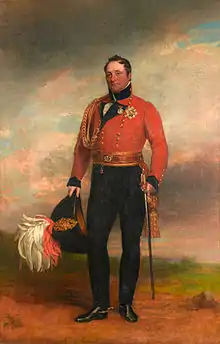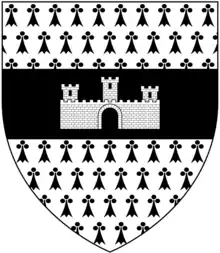Rowland Hill, 1st Viscount Hill
General Rowland Hill, 1st Viscount Hill, GCB, GCH (11 August 1772 – 10 December 1842) was a British Army officer. He served in the Napoleonic Wars as a brigade, division and corps commander. He became Commander-in-Chief of the British Army in 1828.
| The Viscount Hill | |
|---|---|
 Lieutenant-General Rowland Lord Hill, 1819. Canvas by George Dawe | |
| Born | 11 August 1772 Prees, Shropshire |
| Died | 10 December 1842 (aged 70) Hadnall, Shropshire |
| Allegiance | |
| Service/branch | |
| Years of service | 1790–1842 |
| Rank | General |
| Commands held | II Corps |
| Battles/wars | Napoleonic Wars Peninsular War |
| Awards | Knight Grand Cross of the Order of the Bath Knight Grand Cross of the Royal Guelphic Order Grand Cross of the Order of the Tower and Sword (Portugal) Knight Commander of the Military William Order (Netherlands) |

Arms of Hill: Ermine, on a fesse sable a castle triple towered argent[1]
Footnotes
- Montague-Smith, P.W. (ed.), Debrett's Peerage, Baronetage, Knightage and Companionage, Kelly's Directories Ltd, Kingston-upon-Thames, 1968, p.577
References
- Burke, Edmund (1813). The Annual register, or, A view of the history, politics, and literature for the year 1813, Volume 149.
- Dalton, Charles (1904). The Waterloo roll call. With biographical notes and anecdotes. London: Eyre and Spottiswoode.
- Glover, Michael (2001). The Peninsular War 1807–1814. London: Penguin Books. ISBN 0-14-139041-7.
- Hill, Joanna (2011). Wellington's Right Hand: Rowland, Viscount Hill. The History Press Limited. ISBN 978-0752459172.
- Oman, Charles (1993). Wellington's Army, 1809–1814. London: Greenhill. ISBN 0-947898-41-7.
 This article incorporates text from a publication now in the public domain: Chisholm, Hugh, ed. (1911). "Hill, Rowland Hill, 1st Viscount". Encyclopædia Britannica. Vol. 13 (11th ed.). Cambridge University Press. pp. 466–467.
This article incorporates text from a publication now in the public domain: Chisholm, Hugh, ed. (1911). "Hill, Rowland Hill, 1st Viscount". Encyclopædia Britannica. Vol. 13 (11th ed.). Cambridge University Press. pp. 466–467.
Other websites
- Hansard 1803–2005: contributions in Parliament by the Viscount Hill
| Military offices | ||
|---|---|---|
| Preceded by The Lord Forbes |
Colonel of the 3rd Garrison Battalion 1809 |
Succeeded by Baldwin Leighton |
| Preceded by Francis Dundas |
Colonel of the 94th Regiment of Foot 1809–1815 |
Succeeded by Unknown |
| Preceded by Sir James Henry Craig |
Governor of Blackness Castle 1812–1814 |
Succeeded by The Earl of Lindsey |
| Preceded by The Duke of Richmond |
Governor of Kingston-upon-Hull 1814–1830 |
Succeeded by The Earl Cathcart |
| Preceded by James Stuart |
Colonel of the 72nd Regiment of Foot 1815–1817 |
Succeeded by Sir George Murray |
| Preceded by Sir John Abercromby |
Colonel of the 53rd (Shropshire) Regiment of Foot 1817–1830 |
Succeeded by Lord FitzRoy Somerset |
| Preceded by The Duke of Wellington |
Commander-in-Chief of the Forces 1828–1842 |
Succeeded by The Duke of Wellington |
| Preceded by The Duke of Cumberland |
Colonel of the Royal Regiment of Horse Guards (The Blues) 1830–1842 |
Succeeded by The Marquess of Anglesey |
| Preceded by The Earl Harcourt |
Governor of Plymouth 1830–1842 |
Office abolished |
| Parliament of the United Kingdom (1801–present) | ||
| Preceded by William Hill Henry Grey Bennet |
Member of Parliament for Shrewsbury 1812–1814 With: Henry Grey Bennet |
Succeeded by Richard Lyster Henry Grey Bennet |
| Peerage of the United Kingdom | ||
| New creation | Viscount Hill 1842 |
Succeeded by Rowland Hill |
| Baron Hill 1814–1842 |
Extinct | |
| Baron Hill 1816–1842 |
Succeeded by Rowland Hill | |
Wikisource has original writing related to this article:
This article is issued from Wikipedia. The text is licensed under Creative Commons - Attribution - Sharealike. Additional terms may apply for the media files.